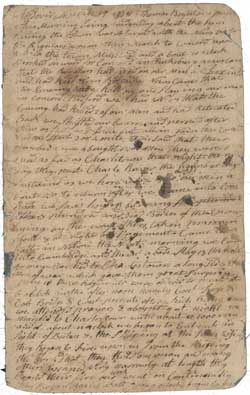Thomas Boynton journal, 19 April- 26 August 1775
To order an image, navigate to the full
display and click "request this image"
on the blue toolbar.
-
Choose an alternate description of this item written for these projects:
- Main description
[ This description is from the project: Coming of the American Revolution ]
A fragment of the journal of Andover minuteman Thomas Boynton, kept in Andover and Charlestown, Mass., 19 April - 26 August 1775. Boynton served under Captain Benjamin Ames in Colonel James Frye’s regiment of the Massachusetts Militia. The four brief entries describe the regiment’s response to the Lexington alarm and their participation in the Battle of Bunker Hill.
Sounding the Alarm
At 10:00 P.M. on the night of 18 April, approximately 800 British grenadiers and light infantry begin making their way to the Back Bay. Once gathered there, they are ferried across the Charles River basin to Cambridge. Again they muster, and at two o'clock in the morning they set out in the direction of Concord. As they march, they hear shots in the distance, a signal for minutemen to pick up their arms, for the Regulars are on the move. At 4:30 A.M., when they reach Lexington Green, the Regulars encounter resistance. Eight militiamen are killed and ten wounded, but the Regulars push on and reach Concord by 7 A.M. Along the way they hear more gunshots, church bells, and drum beats sounding the alarm throughout the countryside. In far-flung towns such as Andover, 17 miles northeast of Concord, militiamen like Thomas Boynton rally to assist their brethren.
Questions to Consider
1. Create a timeline of Boynton's journey with the minutemen. Which towns do they pass through, and at what time? For each town, make a note of what Boynton saw or heard there.
2. According to Boynton, how many British regulars were marching? How does this figure compare to that mentioned in other documents or in your textbook? Why might Boynton's number be different?
Further Exploration
3. Imagine that you are a young minuteman like Thomas Boynton. Write a letter to you friend in Charleston, South Carolina, describing your activities on 19 April. Be sure to describe your emotions during that day and your reactions to the news you were hearing as you passed through different towns.
4. Compare Boynton's account with another account of the events at Lexington and Concord. What is the same in each narrative? What is different?

